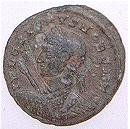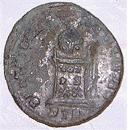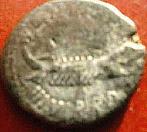|
|
|
Coins during the Empire were struck (rather than cast). There were no assembly lines or punching machines--each coin was struck by hand. First the engraver created two punches out of bronze, one for the obverse (the "heads") of the coin and one for the reverse (the "tails"). The engraver carved the coin's design into the punch in intaglio. The obverse punch was placed on a table, then a blank metal disk, or flan, that was to become the coin was placed on top of the obverse punch. Sometimes the flan was heated and sometimes it was cold. The reverse punch was placed on top of the flan and was then struck by a hammer.
It's easy to see why many Roman coins were often struck off-centre so that part of the design was lost off the edge of the coin, or the coin did not have a uniform thickness. For these reasons, most collectors place a higher value on a commonly found but well struck coin, than they do on a less common but poorly made one. After making thousands of coins with this method, the punch would begin to distort and flatten, making coins that were less pleasing to the eye. Eventually new punches would have to be carved.
Most modern currency has a numerical value clearly printed on it. Although the purchasing power of a U.S. dollar, for instance, will vary according to inflation, the dollar holds its value relative to the other types of currency in the system (e.g., quarters, 5-dollar bills, and 100-dollar bills). This is not true of Roman currency.
Roman coins did not have any denomination, per se--there was no numerical value printed on a coin. A coin's value was based on the relative values of the precious metals (bronze, silver, and gold) that it was made from. So a gold coin was literally worth its weight in gold. Since there are an infinite number of weights, however, it is convenient to have coins that are a set weight, and thus a set relative value. Fluctuations in the values of precious metals and changes in Roman economy resulted in occasional retariffs, which changed the relative values of the coins.
In times of economic trouble, coins were made on the cheap. A silver coin might be made with 80% silver and 20% base metal, or the physical weight of the coin might be reduced, yet in both these cases the coin was still traded at its original value (as if it were pure precious metal and its original size). When the value of the metal in a coin is less than the buying power of the coin, the coin is said to be debased. This is obviously not a good thing. If further debasement occurs, a coin may be devalued, which means that the coin's value decreases relative to other coins in the system. A coin that has undergone substantial debasement may also be discontinued, as eventually happened with the antoninianus.
Because coins were made of precious metals, the Romans dealt with money differently than we do. For instance, dishonest people would shave a little off the edges of their coins before spending them (this was illegal). Over time they could save up a lot of silver and gold.
Coins were legally mutilated for two reasons: 1) coins were cut in half to make change, and 2) merchants sometimes made a test cut on a coin, slicing into the middle of it to ensure that what appeared to be a silver coin was solid silver and not really a bronze coin with a silver wash over it.
During the Early Empire, the denarius (a silver coin) was the basic denomination, much as the dollar is in the U.S. and the pound is in England. In 23 BC, Augustus overhauled the coinage system creating the following relationships:
1 Aureus= 25 Denarii
1 Denarius = 4 Sestertii = 8 Dupondii = 16 Asses = 64 Quadrans

Roman
Silver Coins
Roman coins are a common
find on any site that has had Romans walking on it. Bronze and
copper coins usually come up in terrible state, commonly known as
'cruds'. Silver coins usually come up out of the ground in much
better condition, the silver coins above being Denarius.


Roman AE4
Obverse: legend =
IVL CRISPVSNOB Reverse: legend = BEATA TRANVILLITAS, picturing a
globe on altar VOTIS XX
The coin comes from the reign of Flavius Julius Crispus, AD317-326,
he was the eldest son of Constantine the Great. The earlier
coins depict him armed
(as this one). He was executed in AD326.

Roman Denarius
The coin pictured above is a Mark Anthony Denarius circa 40BC (Seaby's 455). This one is in fact attributed to LEG IX (Hispania) the lettering on the obverse along with the familiar Roman galley. On the reverse it has the legionary eagle between two standards. For those interested - Legio IX (Hispania) was one of 10 of Cearar's legions known in 51 BC, it saw service in Spain, Africa & Pannonia before joining-up with II, XIV & XX legions for the conquest of Britain AD 43. Defeated by Boudicia in AD 60 and subsequently served in Peterborough, Lincoln & York.About AD 122 - departed the country for service in Nijmegan (Holland) and left for Cappadocia and obscurity around AD161. This lovely little silver coin was minted about 40BC, some 10 years before Mark Anthony and Cleopatra committed suicide at Alexandria, Egypt in 30BC.
The Find Pages And Other Links